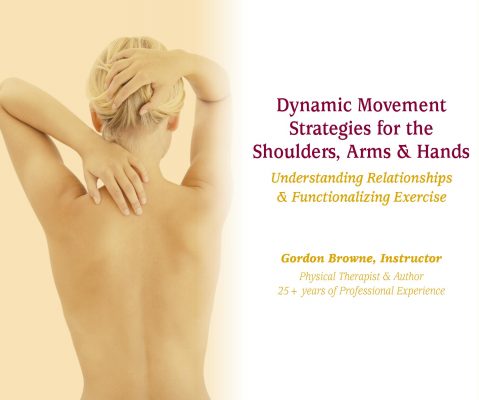Dynamic Movement Strategies for the
Shoulders, Arms & Hands
Understanding Relationships & Functionalizing Exercise
16 Hours/CEUs
Course Description
In this fun and interactive movement course, we will observe, analyze and participate in movement based exercises while learning new treatment strategies designed for immediate clinical application. This course will focus primarily on scapulo-thoracic coordination with, and influences upon, the arm and hand. The hands are at the end of a long line of support systems that we can liken to a crane—a strong but moveable base, various vulnerable pivot points/levers and a point of interaction with the environment. We will explore both experientially and intellectually how the slinky-like rib cage and thoracic spine constitute a mobile and flexible base from which the arms can move. Thoracic integration, scapular control and muscle coordination will feature prominently—rib cage mobility, dynamic scapular stability, synergistic muscle regulation and antagonist balance are emphasized over static scapular stabilization or individual muscle strengthening. Informational movement sequences are built around functional contexts of reaching, grasping, manipulating, pushing, pulling and holding—connecting the dots between exercise and ADLs is imperative for long lasting results. Come and experience this fresh approach to optimizing movement that introduces ways of making the exercises we prescribe more informative, more functional and much more effective.
Course Objectives
By the completion of this course, the participant will be able to:
- Define Regional Interdependence & Specificity Principle
- Identify long-term habitual movement and postural mistakes and correlate to GH bursitis, tendinosis, impingements/instabilities, frozen shoulder, tennis/golfer’s elbow, forearm myofascial syndromes, carpal tunnel, various UE fractures, DeQ and more
- List three primary differences between Static Integration & Dynamic Integration exercise
- Define the difference between Global & Differentiated movement or postural patterns—list two examples of each in the arm and shoulder girdles
- List three principles of Optimal Movement and give examples of common shoulder and upper extremity clinical presentations resulting from sub-optimal movement
- Explain the benefits of informational exercise strategies—use of constraints, change of venue, reciprocating movements, goldilocks principle and link to functional context
Course Outline
Lab sessions include experiential movement, partner observations, facilitation techniques, modifications & discussion of clinical relevance.
Day 1
7:45-8:00—Registration and Snacks
8:00-9:45—Introduction to Integrated Movement
- Comparing Dynamic & Static Integration Movement Principles
- Language of Integrated Movement: Global & Differentiated Relationships
- Course Overview/Themes: Common UE Traumatic & Repetitive Stress Injuries
10:00-12:00—Lab I: Effort Minimization, Hand Differentiations & Diagonals
- Floppy Hands & Ladies’ Hands: Recognition & Control of Unnecessary Effort
- Wrist/Finger Differentiations & Encouraging Tenodesis
- Forearm, Elbow & Wrist Issues: Balancing Antagonists & Minimizing Co-Contractions
1:00-3:05—Lab II: Scapulo-Thoracic Relationships I—Anchoring the Arm in Abduction
- Thoracic Diagonals: Extension with Posterior Tilt & Flexion with Anterior Tilt
- Shoulder Girdle Diagonals & Force Couples: Balancing & Mobilizing UE Support
- Reciprocating Differentiated Movements: Balancing & Re-Calibrating Antagonists
3:20-5:30—Lab III: Scapulo-Thoracic Relationships II—Anchoring the Arm in Flexion
- Orienting the Glenoid: Scapular Integration vs Scapular Stabilization
- The Grand Coalition of the Arm: Thoraco-Scapular-GH Relationships
- Controlling Impingements & Training the Rotator Cuff: Coordinating Synergists
Day 2
8:00-9:45—Lab IV: Upper Extremity Differentiations—SG/GH & GH/Forearm
- Differentiating Humeral & Forearm Rotation: Functional Relevance & Pattern Specificity
- Linking Exercise to Functional Context: Use of Object Facilitators
- Maintaining SG Posterior Tilt/Depression with GH Internal Rotation
10:00-12:00—Lab V: Other Directions—Reaching Behind Back, Overhead & Across
- Exercise Progressions: Building On Previous Learning & Extrapolation to ADL’s
- Limbs Moving as Extension of Dynamic Torso: Appropriate Distribution of Movement
- Change of Venue Variations: Facilitating Patient Pattern Recognition & Problem-Solving
1:00-3:05—Lab VI: Closed Kinetic Chain Variations
- Reversing Origin & Insertion: Bypassing Habitual Muscle Activation Patterns
- Mobilization or Stabilization: Taking a Patient-Centered & Individualized Approach
- De-Coupling Serratus Anterior from Abdominals & Anterior Intercostals
3:20-5:30—Lab VII: Resistance & Endurance
- Putting it All Together: Integrative Drills, Toys & Yoga Derivatives
- Review Objectives, Questions & Wrap Up

State Approvals
We submit all our courses for continuing education approval in the state in which it is being held, if required. For more information please visit our State Approvals page
Registration Fee
| Single Registrant | $425 |
| 2 to 4* | $405 |
| 5 or more* | $370 |
*Price per person when registering at the same time. Please call if paying separately.
Brochure
Download the BrochureTestimonials
"Best class I’ve ever taken, love that we actually move!"
"Gordon was the best presenter of any course I’ve been to, highly recommend!"
"Your courses have dramatically changed the way I treat patients, as well as myself. Life changing for sure!"
"Loved the integration of full body movements. Interesting concepts that can be easily modified for many patients. I’ll use with ortho shoulder pts and in the pool."
"Working in a rehab setting this information is really useful for all types of pts I see, great stuff!"
"Great functional applications, course content relevant to all disciplines. Great job Gordon!"
"Fabulous course; useful for all patients, all ages-including myself!"
 Gordon Browne, PT
Gordon Browne, PT